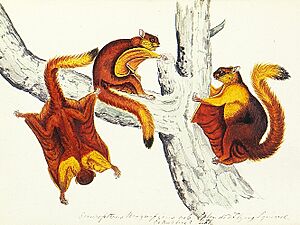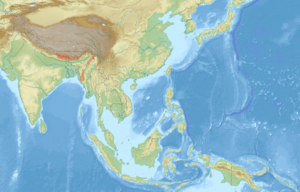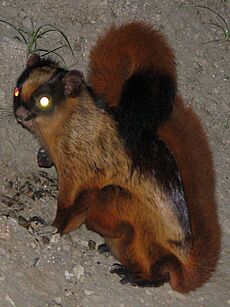Hodgson's giant flying squirrel facts for kids
Quick facts for kids Hodgson's giant flying squirrel |
|
|---|---|
 |
|
| Three individuals painted for the planned—but never published—book on animals of Nepal by 19th century naturalist B.H. Hodgson | |
| Conservation status | |
| Scientific classification | |
| Genus: |
Petaurista
|
| Species: |
magnificus
|
 |
|
| Range in red as reported by the IUCN, but see text | |
The Hodgson's giant flying squirrel (Petaurista magnificus) is a large rodent that lives in the Himalayan forests of Asia. It's called a "flying squirrel" because it can glide long distances between trees. It does this by spreading out a special flap of skin called a patagium that connects its front and back legs.
This amazing creature is nocturnal, which means it is active at night and sleeps during the day. It doesn't actually fly like a bat or a bird, but its gliding ability helps it move quickly through the forest canopy.
Contents
Where This Squirrel Lives
The Hodgson's giant flying squirrel makes its home in the Himalayan region. You can find it in countries like Nepal, Bhutan, and parts of China (southern Xizang, also known as Tibet). It also lives in some Indian states, including Sikkim, northern West Bengal, and much of Arunachal Pradesh.
Scientists are still studying exactly where these squirrels live. Some reports have mentioned them in Bangladesh, Myanmar, and other parts of India. However, it's possible these sightings were actually other types of giant flying squirrels that look similar.
These squirrels live at different heights in the mountains, from about 400 to 3,700 meters (1,300 to 12,100 feet) above sea level. They prefer forests, including tropical, subtropical, and temperate broadleaf forests. They seem to like forests where trees lose their leaves in certain seasons (called deciduous forests) more than those with trees that stay green all year (called evergreen forests).
How It Got Its Name and What It Looks Like
This squirrel was first named in 1836 by a naturalist named Brian Houghton Hodgson. He called it Sciuropterus magnificus. Later, it was moved into the group of other giant flying squirrels, called Petaurista. The English name "Hodgson's giant flying squirrel" was given to honor him.
Brian Houghton Hodgson was a very important person in studying animals in India. He wanted to create a big book about the mammals and birds of Nepal, but sadly, it was never published. Luckily, the beautiful pictures he planned for the book, including one of three Hodgson's giant flying squirrels, are now kept in the Natural History Museum in London.
Appearance
The Hodgson's giant flying squirrel is quite large! Its body, from head to tail base, is about 36 to 51 centimeters (14 to 20 inches) long. Its tail is even longer, measuring about 41.5 to 55 centimeters (16 to 22 inches). These squirrels weigh around 1.35 to 1.8 kilograms (3 to 4 pounds). Sometimes their tail is longer than their body, and sometimes it's shorter.
Their fur has some interesting colors. Their shoulders are usually cream–buff or golden–yellow. This color stands out against their reddish–chestnut, maroon, or russet upper parts, including their sides. The middle of their back often looks dark, sometimes with black hairs. The top of their head is dark and connects to the dark back. Their belly is chestnut–orange or orange–buff. The tail is dark brown at the base, reddish-brown in the middle, and black at the tip. Their feet are also black.
Telling It Apart From Other Squirrels

For a long time, the Hodgson's giant flying squirrel was often confused with another species called the Bhutan giant flying squirrel (Petaurista nobilis). They live in the same areas and look similar. Some scientists even thought they were the same species, or just different versions of the same squirrel that appeared in different seasons.
However, in the late 1970s and early 1980s, scientists finally confirmed that they are two different species. The Bhutan giant flying squirrel is generally a bit bigger. It also has sides that are similar in color to its shoulders. Sometimes, it has a light stripe down its back and a pale patch on its head, which can make its dark head look a bit like a bandit mask. These differences help experts tell the two species apart.
Behaviour
As mentioned, Hodgson's giant flying squirrels are active at night. When the sun sets, you might hear their loud calls as they come out of their hiding spots high in the trees. They then glide down from the treetops to lower plants like rhododendrons and bushes. They can glide as far as 100 meters (330 feet)! Their glide usually ends with a short upward movement as they land.
These squirrels eat a variety of foods. Their diet includes fruits, especially nuts like chestnuts and acorns. They also munch on young leaves, buds, flowers, grass, tree resin, and even insects. During the day, they sleep in tree holes, usually about 5 to 15 meters (16 to 49 feet) above the ground. They line their cozy sleeping spots with soft plants and fur.
Reproduction and Life Cycle
Not much is known about how these squirrels have babies. However, pregnant females have been seen in November. Giant flying squirrels usually have only one baby at a time, but sometimes they can have two.
Status
The total number of Hodgson's giant flying squirrels is believed to be going down. However, they live in many different places, including several protected areas. Because they are still quite widespread, the IUCN (International Union for Conservation of Nature) lists them as a species of "least concern". This means they are not currently in immediate danger of disappearing.
The biggest threats to these squirrels are losing their forest homes and their habitats becoming damaged. They are also sometimes hunted for their meat and fur, or captured to be sold as pets. Unfortunately, squirrels kept as pets often don't live very long. Free-ranging dogs can also sometimes kill Hodgson's giant flying squirrels.


